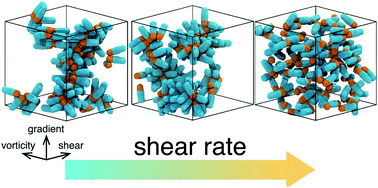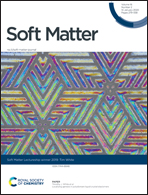Structure and dynamics of amphiphilic Janus spheres and spherocylinders under shear†
Abstract
We study the structure formation and flow properties of colloidal dispersions comprised of Janus spheres, Janus spherocylinders, and their mixtures, using hybrid molecular dynamics simulations that take into account hydrodynamic interactions. We systematically vary the Janus balance and the shape anisotropy of the particles, and explore a range of colloid volume fractions in the liquid regime of the phase diagram. At rest, Janus spheres with small hydrophobic patches form spherical micelles for all investigated colloid concentrations. In contrast, Janus spheres with an entirely hydrophobic hemisphere aggregate to larger worm-like micelles and network-like structures. Janus spherocylinders exhibit a similar self-assembly behavior. At small and intermediate shear, we observe deformation and rearrangement of the micelles, accompanied by a Newtonian-like rheology with slightly higher shear viscosity compared to homoparticle dispersions at the same concentration. As the shear rate is increased further, the micelles eventually break up into small dimers and free particles, causing a distinct shear-thinning of the dispersions. The network-like structures exhibit a similar flow behavior at high shear rates, but for weak shear we find an almost threefold increase of the shear viscosity and a distinct shear-thinning behavior due to the fracturing of the intertwined networks. In general, we identify a strong correlation between the size of the aggregates and the rheology of the dispersions, allowing for the determination of dynamic properties solely based on structural information.



 Please wait while we load your content...
Please wait while we load your content...